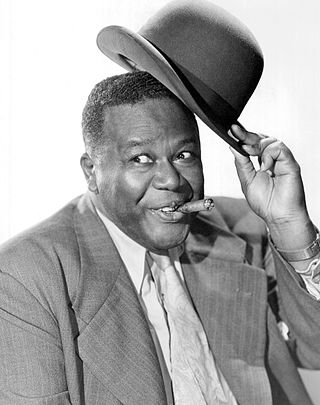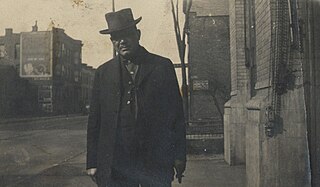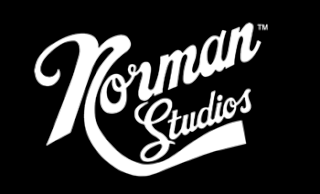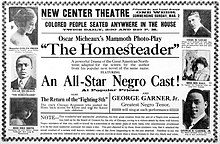
Oscar Devereaux Micheaux (; was an American author, film director and independent producer of more than 44 films. Although the short-lived Lincoln Motion Picture Company was the first movie company owned and controlled by black filmmakers, Micheaux is regarded as the first major African-American feature filmmaker, a prominent producer of race films, and has been described as "the most successful African-American filmmaker of the first half of the 20th century". He produced both silent films and sound films.

Spencer Williams was an American actor and filmmaker. He portrayed Andy on TV's The Amos 'n' Andy Show and directed films including the 1941 race film The Blood of Jesus. Williams was a pioneering African-American film producer and director.

Evelyn Preer, was an African American pioneering screen and stage actress, and jazz and blues singer in Hollywood during the late-1910s through the early 1930s. Preer was known within the Black community as "The First Lady of the Screen."

Juano G. Hernández was a Puerto Rican stage and film actor who was a pioneer in the African American film industry. He made his silent picture debut in The Life of General Villa, and talking picture debut in an Oscar Micheaux film, The Girl from Chicago, which was directed at black audiences. Hernández also performed in a series of dramatic roles in mainstream Hollywood movies. His participation in the film Intruder in the Dust (1949) earned him a Golden Globe Award nomination for "New Star of the Year." Later in life he returned to Puerto Rico, where he intended to make a film based on the life of Sixto Escobar.

Hallelujah is a 1929 American pre-Code Metro-Goldwyn-Mayer musical directed by King Vidor, and starring Daniel L. Haynes and Nina Mae McKinney.

The Lincoln Motion Picture Company was an American film production company founded in 1916 by Noble Johnson and George Perry Johnson. Noble Johnson was president of the company, and the secretary was actor Clarence A. Brooks. Dr. James T. Smith was treasurer, and Dudley A. Brooks was the assistant secretary. The company is known as the first producer of race movies. Established in Omaha, Nebraska, the company relocated to Los Angeles the following year. It remained in operation until 1923, closing shortly after announcing a final project, The Heart of a Negro. The point of the creation of Lincoln's was to eliminate the stereotypical roles of "slapstick comedy" in Hollywood at the time for Black actors and actresses. "best advertised and most widely known Race Corporation in the world" is the famous slogan for the company.
Midnight Ramble is a 1994 documentary about the early history of Black American movies from the period between 1910 and 1950. Known as "race movies", these films, traditionally independent of Hollywood, were made primarily by, for and about the black community. This documentary is a tribute to a film genre that lasted for more than 40 years, produced over 500 movies, and created a foundation for contemporary films from directors such as Spike Lee and Tyler Perry. James Avery narrates this exploration of the early black film industry. There is a mistaken assumption that "race films" began largely in reaction to D. W. Griffith's 1915 The Birth of a Nation. Nothing could be further from the truth. Race movies actually began around 1910 in Chicago in response to the Black Community longing to see themselves reflected on the silver screen via this new medium of film. Wanting to see themselves through their own eyes, on their own terms thus counteracting the Hollywood stereotypes within the American media.

Blaxploitation is an ethnic subgenre of the exploitation film that emerged in the United States during the early 1970s. After the demand of the Black panthers for black artists to reclaim the power and rights to their image from the UCLA and the new rating system within Hollywood allowed up and coming black film makers and actors to create black films for black audiences. The term, a portmanteau of the words "black" and "exploitation", was coined in August 1972 by Junius Griffin, the president of the Beverly Hills–Hollywood NAACP branch. He claimed the genre was "proliferating offenses" to the black community in its perpetuation of stereotypes often involved in crime. After the race films of the 1940s and 1960s, the genre emerged as one of the first in which black characters and communities were protagonists, rather than sidekicks, supportive characters, or victims of brutality. The genre's inception coincides with the rethinking of race relations in the 1970s.

Francine Everett was an American actress and singer.
The Notorious Elinor Lee is a 1940 race film directed, written, and co-produced by the African-American filmmaker Oscar Micheaux.
The Ethiopian Art Theatre — originally called the Chicago Folk Theatre, later the Colored Folk Theatre, also referred to as The Ethiopian Art Players — was an African American theatre company based out of Chicago, Illinois. The company was an influential albeit short-lived (1922/1923–1925) group founded during the Harlem Renaissance. There are differing views over the precise year that the company was founded, 1922 or 1923. The founder was Raymond O'Neil, a white theatre director, and its principal sponsor was Mrs. Sherwood Anderson, also white; though all its performers were African American. The organization was unique and controversial during its era, primarily for being one of the few African American Theatre Companies to perform European theatrical works, but also, among other things, for producing theatrical works of African American playwrights for both African American and Non-African American audiences.

William D. Foster, sometimes referred to as Bill Foster, was a pioneering African-American film producer who was an influential figure in the Black film industry in the early 20th century, along with others such as Oscar Micheaux. He was the first African American to found a film production company, establishing the Foster Photoplay Company in Chicago in 1910. Foster had a vision for the African-American community to portray themselves as they wanted to be seen, not as someone else depicted them. He was influenced by the black theater community and wanted to break the racial stereotyping of blacks in film. He was an actor and writer under the stage name Juli Jones, as well as an agent for numerous vaudeville stars. His film The Railroad Porter, released in 1912, is credited as being the world's first film with an entirely black cast and director. The film is also credited with being the first black newsreel, featuring images of a YMCA parade. Foster's company produced four films that were silent shorts.

Norman Studios, also known as Norman Film Manufacturing Company is a former American film studio in Jacksonville, Florida. Founded by Richard Edward Norman, the studio produced silent films featuring African-American casts from 1919 to 1928. The only surviving studio from the period of early filmmaking in Jacksonville, its facilities are now the Norman Studios Silent Film Museum.
Blaxploitation horror films are a genre of horror films involving mostly black actors. In 1972 director William Crain did the first blaxploitation horror film, Blacula.
David Starkman (1885-c.1947) was an American film producer who helped found Colored Players Film Corporation, an independent silent film studio. He wrote and produced the film company's most famous film The Scar of Shame.
Imaging Blackness is the complex concept of expressing, recognizing, or assigning specific sets of ideas or values used in the depiction of blacks. This depiction can be shown through various forms of media: film, television, literature. More specifically in film, the portrayal of blacks has been imaged and captured throughout history.
The presence of African Americans in major motion picture roles has stirred controversy and been limited dating back decades due to lingering racism following slavery and segregation. "Through most of the 20th century, images of African-Americans in advertising were mainly limited to servants like the pancake-mammy Aunt Jemima and Rastus, the chef on the Cream of Wheat box." While African American representation in the film industry has improved over the years, it has not been a linear process; "Race in American cinema has rarely been a matter of simple step-by-step progress. It has more often proceeded in fits and starts, with backlashes coming on the heels of breakthroughs, and periods of intense argument followed by uncomfortable silence."
Pearl Bowser was an American author, collector, television director, film scholar, film director, producer, filmmaker, independent distributor and film archivist. Along with her peers Mel Roman and Charles Hobson, Bowser researched and curated "The Black Film" retrospective at the Jewish Museum in 1970. This prompted a new wave of public interest into "exhibiting, producing, and engaging with African American cinema beyond borders". Most of her exalted career was spent traveling the globe in order to cultivate audiences for marginalized filmmakers. An example of her efforts, and also her most groundbreaking work, manifested in her research on "early-1900s Black film pioneer Oscar Micheaux". This research can be seen in her book on the first ten years of the career of Oscar Micheaux, an African-American who directed 40 "race pictures" between 1918 and 1940. She is thus credited for having helped rediscover some of Oscar Micheaux's rare surviving films. She is the founder of African Diaspora Images, a collection of visual and oral histories that documents the history of African-American filmmaking. Part of her journey included teaching young people film in the 1960s and 1970s.

African American cinema is loosely classified as films made by, for, or about Black Americans. Historically, African American films have been made with African-American casts and marketed to African-American audiences. The production team and director were sometimes also African American. More recently, Black films featuring multicultural casts aimed at multicultural audiences have also included American Blackness as an essential aspect of the storyline.
African-Americans in film refers to the history, contributions, and representation of African-Americans in the film industry. This article covers the evolution of African-American roles in film, including notable filmmakers, actors, and films, as well as the challenges and achievements of African-Americans in the industry.












